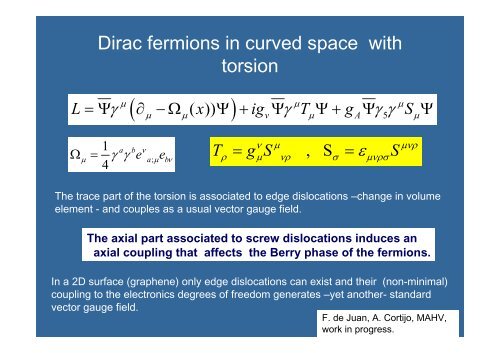General relativity and graphene
General relativity and graphene
General relativity and graphene
You also want an ePaper? Increase the reach of your titles
YUMPU automatically turns print PDFs into web optimized ePapers that Google loves.
Dirac fermions in curved space with<br />
torsion<br />
( ( )) ) v A 5<br />
L = Ψγ µ ∂ −Ω x Ψ + ig Ψγ µ T Ψ+ g Ψγ γ<br />
µ S Ψ<br />
µ µ µ µ<br />
Ω =<br />
1<br />
γ γ e<br />
4<br />
e<br />
a b ν<br />
µ a;<br />
µ bν<br />
T = g S , S =ε S<br />
ν µ µνρ<br />
ρ µ νρ σ µνρσ<br />
The trace part of the torsion is associated to edge dislocations –change in volume<br />
element - <strong>and</strong> couples as a usual vector gauge field.<br />
The axial part associated to screw dislocations induces an<br />
axial coupling that affects the Berry phase of the fermions.<br />
In a 2D surface (<strong>graphene</strong>) only edge dislocations can exist <strong>and</strong> their (non-minimal)<br />
coupling to the electronics degrees of freedom generates –yet another- st<strong>and</strong>ard<br />
vector gauge field.<br />
F. de Juan, A. Cortijo, MAHV,<br />
work in progress.
















